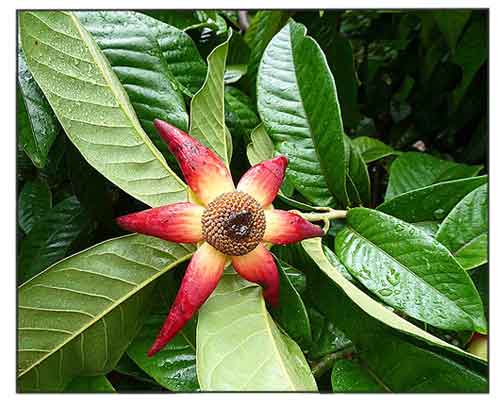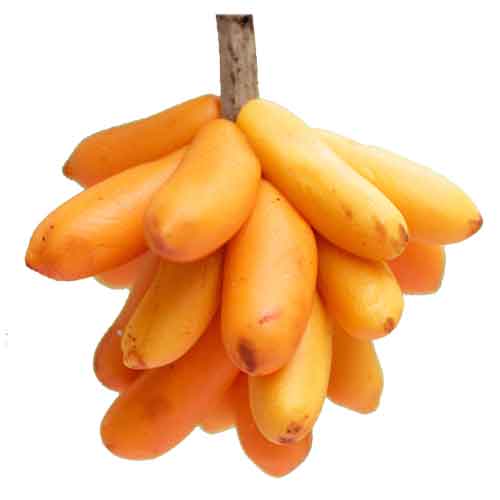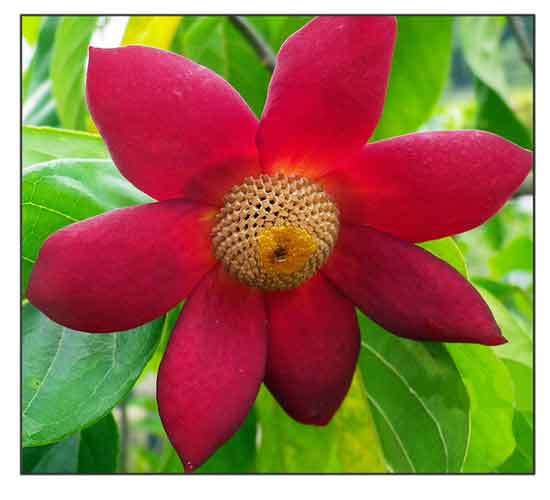 Gen info Gen info
- Uvaria grandiflora is an Asian liana species in the family Annonaceae and tribe Uvarieae.
- As of 2021, there are 168 accepted Uvaria species.
-
Etymology: The genus names uvaria derives from Latin uvarius, uva meaning "grape", likely referring to the edible fruit of some species in the genus resembling grapes. (3) Grandiflora is a combination of Latin terms grandis "great" and flos "flower" referring to the large flower, this species having the biggest in the genus.
Botany
• It is a woody, scrambling climber or shrub, up to 10 m tall. Foliage: Its alternate, stalked leaves have thinly membranous blades that are oblong-lance shaped to elliptic-oblong, shiny dark green above and pale green below, and 11–23 by 6–9.5 cm. Its midrib is slightly depressed above, prominent beneath, and veins are prominent on both sides. The leaf stalks and young leaves are hairy. Stems:The young stems are pubescent to tomentose. Flowers:The solitary, bisexual flowers are opposed to the leaves and measure about 9 to 11 cm wide. The calyx consists of 3 yellowish sepals which are 2 to 2.5 cm long and are broadly triangular in shape. The corolla consists of 6 dark red obovate to ovate petals, 3.5 to 4 cm long. The flowers are slightly fragrant. Fruits: Its orange and fleshy fruits compose of distinct, hairy fruitlets or carpels, each fruitlet is berry-like and cylindrical, 4–5.5 cm long, being slightly constricted around the brown seeds. Each fruit contains seeds that are flat, pale brown, and oval-shaped arranged in 2 rows.
 • Shrubs to 10 m tall, climbing, densely stellate pubescent to ferruginous tomentose throughout. Petiole 5-8 mm; leaf blade oblong-obovate, 7-30 × 3.5-12.5 cm, papery to thinly leathery, secondary veins 10-17(-24) on each side of midvein and at ca. 60° to midvein, base shallowly cordate, apex acute, shortly acuminate, or sometimes caudate. Inflorescences leaf-opposed, cymose, 1(-3)-flowered; bracts 2, ovate to obovate, ca. 3 × 2.5 cm. Flowers 7-10 cm in diam. Pedicel 0.5-5 cm. Sepals broadly ovate, 2-2.5 × 2.5-3.5 cm, connate for basal third, membranous, inside glabrous, apex obtuse to acute. Petals dark red to vermilion red, turning purplish with age, obovate to oval-obovate, 4-4.5 × 2.5-3.5 cm, puberulent. Stamens oblong to linear, 6-7 mm; connectives apically truncate, glabrous. Carpels oblong to linear, ca. 8 mm; ovules 30-50 per carpel, in 2 series; stigmas apically involute and 2-cleft. Monocarp stipes 1.5-3 cm; monocarps orange, cylindric, 4-6 × 1.5-2 cm, slightly constricted between seeds, fleshy, apex mucronate; epicarp not spiny, minutely tomentose. Seeds pale brown, ovoid, flattened. (Flora of China) • Shrubs to 10 m tall, climbing, densely stellate pubescent to ferruginous tomentose throughout. Petiole 5-8 mm; leaf blade oblong-obovate, 7-30 × 3.5-12.5 cm, papery to thinly leathery, secondary veins 10-17(-24) on each side of midvein and at ca. 60° to midvein, base shallowly cordate, apex acute, shortly acuminate, or sometimes caudate. Inflorescences leaf-opposed, cymose, 1(-3)-flowered; bracts 2, ovate to obovate, ca. 3 × 2.5 cm. Flowers 7-10 cm in diam. Pedicel 0.5-5 cm. Sepals broadly ovate, 2-2.5 × 2.5-3.5 cm, connate for basal third, membranous, inside glabrous, apex obtuse to acute. Petals dark red to vermilion red, turning purplish with age, obovate to oval-obovate, 4-4.5 × 2.5-3.5 cm, puberulent. Stamens oblong to linear, 6-7 mm; connectives apically truncate, glabrous. Carpels oblong to linear, ca. 8 mm; ovules 30-50 per carpel, in 2 series; stigmas apically involute and 2-cleft. Monocarp stipes 1.5-3 cm; monocarps orange, cylindric, 4-6 × 1.5-2 cm, slightly constricted between seeds, fleshy, apex mucronate; epicarp not spiny, minutely tomentose. Seeds pale brown, ovoid, flattened. (Flora of China)
Distribution
- Native to the Philippines.
- Also native to Borneo, Cambodia, China, Hainan, Jawa, Laos, Malaya, Myanmar, New Guinea, Sulawesi, Sumatera, Thailand, Vietnam. (1)
 Constituents Constituents
- Study isolated two major triterpenes, suberosol and lupeol. (4)
- Study of roots isolated three new polyoxygenated cyclohexenes, named uvarigranol G-I, along with two known compounds, 1-epizeylenol and zeylenyl 2,6-diacetate. (5)
- Study of bark isolated Grandiuvarone A (1) and grandiuvarins A-C (2-4). (see study below) (6)
- Phytochemical screening of leaves and stem barks yielded alkaloids, flavonoids, and steroids. Ethanol extract of stem bark yielded alkaloids +++, flavonoids +++, steroid +, with absence of tannin, saponin, and cardiac glycosides, with extraction yield of 3.7%. (see study below) (7)
- Study of MeOH-EtOAc (1:1 v/v) soluble fraction partitioned from the MeOH extract of twigs isolated six known compounds viz., four aristolactams (1-4), aristolactam AII (1), aristolactam BI (2), velutinam (3), griffithinam (4), along with isoursuline (5), and sinactine (6). (see study below) (8)
- GC-FID and GC-MS analysis
of essential oils hydrodistilled from leaves of U. grandiflora identified a total of 29 compounds, representing 96.5% of total oil contents. Main classes of compounds identified were monoterpene hydrocarbons (43.3%), oxygenated monoterpenes (13.6%), sesquiterpene hydrocarbons (13.7%) and benezenoid compounds (17.3%). Main compounds were limonene (25.2%), benzyl benzoate (16.0%), α-phellandrene (10.2%), eugenol (7.3%), and 1,8-cineole (6.1%). (10)
- Study of roots isolated two new cytotoxic annonaceous acetogenins, uvarigrin (1) uvarigrandin A (3). (see study below) (12)
- Study of aerial parts isolated a new polyoxygenated cyclohexane, (-)-3-O-debenzoylzeylenone (1), and a new megastigmane glycoside, grandionoside A (2), along with ten known compounds including polyoxygenated cyclohexenes (3-6), a triterpenoid (7), an alkaloid (8), a long chain alcohol (9), hexenyl-glycopyranoside (10), and saponins (11,12). (see study below) (14)
Properties
- Studies have suggested antileishmanial, antioxidant, antibacterial, botanical pesticidal, anti-inflammatory, anticancer, antidiabetic properties.
Parts used
Bark, leaves, roots.
Uses
Edibility
- Fruits are edible, aromatic. Eaten raw or preserved.
Folkloric
- In Malaysia, leaves and roots are eaten to treat abdominal pains and skin diseases. Pound leaves are used to treat putrefaction.
- Used for treating contusions; also as cardiotonic.
 Studies Studies
• Antileishmanial Activity / Bark: Study of bark isolated Grandiuvarone A (1) and grandiuvarins A-C (2-4). Compound 1 exhibited antileishmanial activity, with IC50/IC90 of 0.7/1.5 µg/ml. Positive controls pentamidine and amphotericin B showed IC50/IC90 values of 1.6/6.6 and 0.17/0.34 µg/mL, respectively. (6)
• Antibacterial / Antioxidant / Leaves and Bark: Study evaluated hexane, chloroform, ethanol extracts of leaves and bark of Uvaria grandiflora for antioxidant and antibacterial activities. The bark ethanol extract showed highest flavonoid content and profound antioxidant and antibacterial activities. Growth inhibiting effects of three extracts were tested by paper disc agar diffusion method against six bacteria. Bark ethanol extract at concentration of 2.0 mg/disc exhibited strong inhibiting activity (+++) against B. cereus and S. aureus. The stem bark ethanol extract exhibited highest DPPH radical scavenging activity at 100 µg/ml concentration with 95.32%, compared to leaves at 86.38%. (see constituents above) (7)
• Antioxidant / Alkaloids / Twigs: Study of MeOH-EtOAc (1:1 v/v) soluble fraction partitioned from the MeOH extract of twigs isolated six known compounds viz., four aristolactams (1-4), aristolactam AII (1), aristolactam BI (2), velutinam (3), griffithinam (4), along with isoursuline (5), and sinactine (6). Compound 3, velutinam, showed antioxidant activity in DPPH radical scavenging assay. The isolated compounds did not show antimicrobial activity. (8)
• Zeylenone / Potential as Botanical Fungicide: Study of extract of U. grandiflora exhibited broad-spectrum inhibitory activity toward phytopathogenic fungi and oomycetes, particularly against Colletotrichum musae and Phytophthora capsici. Its secondary metabolite zeylenone also displayed strong antifungal and antioomycete activities against phytopathogens. It showed better inhibitory effects than commercial fungicides (azoxystrobin and osthole). Analysis also showed zeylenone may damage the cytoderm and affect energy metabolism of Phytophthora capsici. (9)
• Anti-Inflammatory / Anticancer / (-)-Zeylenol / Stems: Study isolated zeylenol from the stems of U. grandiflora and was tested for anti-inflammatory activity and cytotoxicity against human breast cancer MDA-MB231 and HepG2 cells. Results showed dose of 1 mg/ear significantly inhibited edema formation by 90. Anti-inflammatory activity may be through inhibition of synthesis or release of various inflammatory mediators. Zeylonol was found toxic to both MDA-MB231 and HepG2 cells in a dose dependent manner with IC50s of 54 and ≥80 µM, respectively. The compound induced MDA-MB231 cell apoptosis via caspase-3 activation. (11)
• Cytotoxic Acetogenins / Roots: Study of roots isolated two new cytotoxic annonaceous acetogenins, uvarigrin (1) uvarigrandin A (3). Compound 1 showed cytotoxicity against HCT-8, Bel-7402, and A-2780 human tumor cell lines at ED-50 levels of 0.15, 0.21, and 0.41 mu-g cntdot ml-1, respectively. (12)
• Anticancer / Polyoxygenated Cyclohexane / Aerial Parts: Study of aerial parts isolated a new polyoxygenated cyclohexane, (-)-3-O-debenzoylzeylenone (1), and a new megastigmane glycoside, grandionoside A (2), along with ten known compounds. Compound 1 exhibited significant cytotoxicity against LU-1 and SK-Mel-2 cell lines with IC50s of 4.68 and 3.63 µM, respectively. Cytotoxicity of 12 against LU-1, KB, HepG2, MKN-7, and SWE-480 cell were were comparable to the positive control, ellipticine, with IC50s ranging from 1.24 to 1.60 µM. (see constituents above) (14)
• Antidiabetes / Zeylenone: Study isolated a new highly oxygenated cyclohexane, uvagrandol (1), along with known compound (-)-zeylenone (2) from DCM sub-extract of U. grandiflora. In vitro and in silico studies assessed their enzyme inhibitory properties against α-glucosidase, dipeptidyl peptidase IV, porcine lipase, and human recombinant monoacylglycerol lipase. Compounds 1 and 2 significantly inhibited the four target enzymes in vitro. Molecular docking simulations showed strong binding affinities for (-)-zeylenone (2), thus validating the invitro results. Results suggest potential of polyoxygenated cyclohexanes, in particular (1)-zeylenone (2) in anti-diabetic and anti-obesity drug discovery. (15)
• Zeylenone / Apoptosis in Colon Cancer Cells: Study evaluated the inhibitory activity of Zeylenone (Zey) on colon carcinoma (HCT-116) cells and explored the possible underlying mechanisms of cancer death. Zey treatment suppressed growth of cell proliferative and metastatic markers such as TNF-α, cyclin D1, PCNA, MMP-2, MMP-9, and Bcl-2 through the downregulation of NF-kB and IkBα in HCT-116. Zey mediated inhibition of NF-kB subsequently induced proapoptotic genes (Bax, cytochome-c, caspase-9, and caspase-3) expressions in HCT-116 cells. Results suggest Zey treatment inhibits proliferation, metastasis, and induces apoptosis, probably by controlling NF-kB signaling in colon cancer cells. (17)
• Endophytic Fungi / Antibacterial / Antioxidant / Toxicity / Leaves: Study isolated endophytic fungi Nigrospora and Colletotrichum spp. from leaves of U. grandiflora. Biological screening showed the fungal endophytes were most active against methicillin-resistant Staphylococcus aureus )MRSA), with the ethyl acetate (EA) broth extract of Colletotrichum sp. showing biggest zone of inhibition (ZOI) for MRSA at 19mm. EA broth extract of Nigrospora sp. showed better antibacterial activity (ZOI>11mm) against S. aureus, E. coli, P. aeruginosa, and K. pneumonia. Nigrospora broth extract showed best free radical scavenging with DPPH, FRAP, and superoxide scavenging assays. Toxicity screening using Artemia salina showed both fungi were toxic with LD50<0.40 mg/mL. (18)
• Synthesis of Grandifloracin: Study reports on the highly efficient synthesis of (±)-grandifloracin, which is amenable to late-stage diversification for the synthesis of analogues. A recent study showed analogue 7d has increased antiproliferative effect compared with grandifloracin on PANC-1 and HT-29 (human colon cancer) cells, both in nutrient-rich (10% fetal bovine serum) and nutrient-deprived conditions (0.5% fetal bovine serum). Study suggests potential for development of grandifloracin analogues for the study and treatment of pancreatic cancer. (19)
In the News
•
Tropical Flowers Offers Hope in Pancreatic Cancer / Grandifloricin: Pancreatic cancer is one of the most difficult cancers to treat, often asymptomatic or low in symptomatology until it has spread to other organs. University of Bath research in collaboration with Prof. Suresh Awale from the University of Toyama, Japan, described three new drug-like molecules inspired by chemical Grandifloracin found in the tropical plant Uvaria grandiflora, which could kill pancreatic cancer cells in a petri dish. Two of the three killed cells more effectively than the original Grandifloracin molecule. The molecules could become a promising new class of drugs for the treatment of pancreatic cancer. (16) (also see: 13)
Availability
Wild-crafted.
Seeds in the cybermarket. |

![]()



 Gen info
Gen info • Shrubs to 10 m tall, climbing, densely stellate pubescent to ferruginous tomentose throughout. Petiole 5-8 mm; leaf blade oblong-obovate, 7-30 × 3.5-12.5 cm, papery to thinly leathery, secondary veins 10-17(-24) on each side of midvein and at ca. 60° to midvein, base shallowly cordate, apex acute, shortly acuminate, or sometimes caudate. Inflorescences leaf-opposed, cymose, 1(-3)-flowered; bracts 2, ovate to obovate, ca. 3 × 2.5 cm. Flowers 7-10 cm in diam. Pedicel 0.5-5 cm. Sepals broadly ovate, 2-2.5 × 2.5-3.5 cm, connate for basal third, membranous, inside glabrous, apex obtuse to acute. Petals dark red to vermilion red, turning purplish with age, obovate to oval-obovate, 4-4.5 × 2.5-3.5 cm, puberulent. Stamens oblong to linear, 6-7 mm; connectives apically truncate, glabrous. Carpels oblong to linear, ca. 8 mm; ovules 30-50 per carpel, in 2 series; stigmas apically involute and 2-cleft. Monocarp stipes 1.5-3 cm; monocarps orange, cylindric, 4-6 × 1.5-2 cm, slightly constricted between seeds, fleshy, apex mucronate; epicarp not spiny, minutely tomentose. Seeds pale brown, ovoid, flattened. (
• Shrubs to 10 m tall, climbing, densely stellate pubescent to ferruginous tomentose throughout. Petiole 5-8 mm; leaf blade oblong-obovate, 7-30 × 3.5-12.5 cm, papery to thinly leathery, secondary veins 10-17(-24) on each side of midvein and at ca. 60° to midvein, base shallowly cordate, apex acute, shortly acuminate, or sometimes caudate. Inflorescences leaf-opposed, cymose, 1(-3)-flowered; bracts 2, ovate to obovate, ca. 3 × 2.5 cm. Flowers 7-10 cm in diam. Pedicel 0.5-5 cm. Sepals broadly ovate, 2-2.5 × 2.5-3.5 cm, connate for basal third, membranous, inside glabrous, apex obtuse to acute. Petals dark red to vermilion red, turning purplish with age, obovate to oval-obovate, 4-4.5 × 2.5-3.5 cm, puberulent. Stamens oblong to linear, 6-7 mm; connectives apically truncate, glabrous. Carpels oblong to linear, ca. 8 mm; ovules 30-50 per carpel, in 2 series; stigmas apically involute and 2-cleft. Monocarp stipes 1.5-3 cm; monocarps orange, cylindric, 4-6 × 1.5-2 cm, slightly constricted between seeds, fleshy, apex mucronate; epicarp not spiny, minutely tomentose. Seeds pale brown, ovoid, flattened. ( Constituents
Constituents
